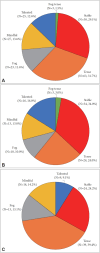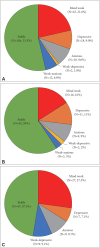Clinical Implication of Maumgyeol Basic Biotypes-Electroencephalography- and Photoplethysmogram-Based Bwave State Inventory
- PMID: 38811002
- PMCID: PMC11136575
- DOI: 10.30773/pi.2023.0381
Clinical Implication of Maumgyeol Basic Biotypes-Electroencephalography- and Photoplethysmogram-Based Bwave State Inventory
Abstract
Objective: The development of individual subtypes based on biomarkers offers a cost-effective and timely avenue to comprehending individual differences pertaining to mental health, independent from individuals' subjective insights. Incorporating 2-channel electroencephalography (EEG) and photoplethysmogram (PPG), we sought to establish a subtype classification system with clinical relevance.
Methods: One hundred healthy participants and 99 patients with psychiatric disorders were recruited. Classification thresholds were determined using the EEG and PPG data from 2,278 individuals without mental disorders, serving to classify subtypes in our sample of 199 participants. Multivariate analysis of variance was applied to examine psychological distinctions among these subtypes. K-means clustering was employed to verify the classification system.
Results: The distribution of subtypes differed between healthy participants and those with psychiatric disorders. Cognitive abilities were contingent upon brain subtypes, while mind subtypes exhibited significant differences in symptom severity, overall health, and cognitive stress. K-means clustering revealed that the results of our theory-based classification and data-driven classification are comparable. The synergistic assessment of both brain and mind subtypes was also explored.
Conclusion: Our subtype classification system offers a concise means to access individuals' mental health. The utilization of EEG and PPG signals for subtype classification offers potential for the future of digital mental healthcare.
Keywords: Biotype; Digital healthcare; Electroencephalography; Mental health; Photoplethysmogram.
Conflict of interest statement
The authors have no potential conflicts of interest to disclose.
Figures



Similar articles
-
Clinical Implication of Maumgyeol Basic Service-the 2 Channel Electroencephalography and a Photoplethysmogram-based Mental Health Evaluation Software.Clin Psychopharmacol Neurosci. 2023 Aug 31;21(3):583-593. doi: 10.9758/cpn.23.1062. Clin Psychopharmacol Neurosci. 2023. PMID: 37424425 Free PMC article.
-
Right care, first time: a highly personalised and measurement-based care model to manage youth mental health.Med J Aust. 2019 Nov;211 Suppl 9:S3-S46. doi: 10.5694/mja2.50383. Med J Aust. 2019. PMID: 31679171
-
Eliminating Individual Bias to Improve Stress Detection from Multimodal Physiological Data.Annu Int Conf IEEE Eng Med Biol Soc. 2018 Jul;2018:5753-5758. doi: 10.1109/EMBC.2018.8513680. Annu Int Conf IEEE Eng Med Biol Soc. 2018. PMID: 30441643
-
Photoplethysmogram Analysis and Applications: An Integrative Review.Front Physiol. 2022 Mar 1;12:808451. doi: 10.3389/fphys.2021.808451. eCollection 2021. Front Physiol. 2022. PMID: 35300400 Free PMC article. Review.
-
Systematic reviews of the effectiveness of day care for people with severe mental disorders: (1) acute day hospital versus admission; (2) vocational rehabilitation; (3) day hospital versus outpatient care.Health Technol Assess. 2001;5(21):1-75. doi: 10.3310/hta5210. Health Technol Assess. 2001. PMID: 11532238 Review.
References
-
- Senaratne H, Oviatt S, Ellis K, Melvin G. A critical review of multimodal-multisensor analytics for anxiety assessment. ACM Trans Comput Healthcare. 2022;3:1–42.
-
- Acharya UR, Sudarshan VK, Adeli H, Santhosh J, Koh JE, Adeli A. Computer-aided diagnosis of depression using EEG signals. Eur Neurol. 2015;73:329–336. - PubMed
-
- Olbrich S, van Dinteren R, Arns M. Personalized medicine: review and perspectives of promising baseline EEG biomarkers in major depressive disorder and attention deficit hyperactivity disorder. Neuropsychobiology. 2015;72:229–240. - PubMed
Grants and funding
LinkOut - more resources
Full Text Sources

